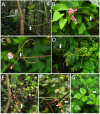Climbing strategies of Taiwan climbers
- PMID: 37736799
- PMCID: PMC10516820
- DOI: 10.1186/s40529-023-00399-4
Climbing strategies of Taiwan climbers
Abstract
Background: The climbing strategies of lianas and herbaceous vines influence climber competition abilities and survival. The aim of this study was to investigate the climbing strategies of each plant species and observe their organs of origin.
Results: The results showed that all Taiwan climbers were approximately 555 species, accounting for 11% of the native flora. Among the 555 climbers, the twining stem type was the most common, with a total of 255 species (46%), the remaining climbing methods accounted for 300 species. Approximately twenty one climbing methods, including nine combination types, were exhibited, of which the most common type was the twining stem, followed by simple scrambling and twining tendrils. Most species of Fabaceae and Apocynaceae were twining stems in dextrorse, excluding Wisteriopsis reticulata and Alyxia taiwanensis, which were in sinistrorse. The prehensile branch of Fissistigma genus, Ventilago genus, and Dalbergia benthamii, originated from second-order or modified stems. In the simple scrambling type, some climbers were covered spines and prickles to attach the host, and the others were clinging to the supports or creeping on the ground without speculation. The hooks or grapnels of the genus Uncaria are derived from the branches, and a pair of curved hooks or a spine of Artabotrys hexapetalus are originated from the inflorescence to tightly attach to a host. The Piper genus use adhesive roots to climb their hosts. Among the genus Trichosanthes, only Trichosanthes homophylla exhibits a combination of twining modified shoots and adhesive roots. Gentianales includes four families with seven climbing mechanisms, while Fabales includes only Fabaceae, which presents six climbing methods.
Conclusions: The twining tendrils had nine organs of origin in Taiwan climber, that these opinions of originated organs might be available to the studies of convergent evolution. The data presented herein provide crucial basic information of the climber habits types and origin structures, which are available for terms standardization to improve field investigation. The terminologies would aid in the establishment of climber habits as commonly taxon-specific and the combination of two climber habits could be a characteristic of taxonomic value.
Keywords: Adhesive pads; Adventitious roots; Climbers; Hooks; Modified organs; Prehensile; Speculation; Strategies; Tendrils.
© 2023. Institute of Plant and Microbial Biology.
Conflict of interest statement
The authors declare that they have no competing interests.
Figures



Similar articles
-
Developmental plasticity and biomechanics of treelets and lianas in Manihot aff. quinquepartita (Euphorbiaceae): a branch-angle climber of French Guiana.Ann Bot. 2009 Jun;103(8):1249-59. doi: 10.1093/aob/mcp078. Epub 2009 Apr 7. Ann Bot. 2009. PMID: 19351684 Free PMC article.
-
The molecular control of tendril development in angiosperms.New Phytol. 2018 May;218(3):944-958. doi: 10.1111/nph.15073. Epub 2018 Mar 9. New Phytol. 2018. PMID: 29520789 Review.
-
A 30-year update of the climbers and vascular epiphytes inventory of the Cerro Ñielol Natural Monument (La Araucanía, Chile): a database.Biodivers Data J. 2021 Sep 15;9:e72521. doi: 10.3897/BDJ.9.e72521. eCollection 2021. Biodivers Data J. 2021. PMID: 34616216 Free PMC article.
-
Gelatinous fibers are widespread in coiling tendrils and twining vines.Am J Bot. 2009 Apr;96(4):719-27. doi: 10.3732/ajb.0800373. Am J Bot. 2009. PMID: 21628227
-
Convergent Evolution and the Diverse Ontogenetic Origins of Tendrils in Angiosperms.Front Plant Sci. 2018 Apr 3;9:403. doi: 10.3389/fpls.2018.00403. eCollection 2018. Front Plant Sci. 2018. PMID: 29666627 Free PMC article. Review.
Cited by
-
A comprehensive dataset of morphological traits for Indian climbers.Data Brief. 2025 Jun 20;61:111810. doi: 10.1016/j.dib.2025.111810. eCollection 2025 Aug. Data Brief. 2025. PMID: 40673168 Free PMC article.
References
-
- Barneby RC. Sensitivae censitae: a description of the genus Mimosa Linnaeus (Mimosaceae) in the New World. Mem N Y Bot Gard. 1991;65:1–835.
-
- Beentje H. The Kew plant glossary an illustrated dictionary of plant terms. Kew: Kew Royal Botanic Gardens; 2010. p. 160.
-
- Burnham R, Revilla-Minaya C. Phylogenetic influence on twining chirality in Lianas from Amazonian Peru. Ann Missouri Bot Gard. 2011;98:196–205. doi: 10.3417/2008080. - DOI
-
- Chang KC, Kung KN. Piper lanyuense (Piperaceae), a new species from Taiwan. Ann Bot Fenn. 2020;57(1–3):93–96. doi: 10.5735/085.057.0113. - DOI
-
- Chao CT, Cheng CL, Wang CM. Ipomoea lacunosa (Convolvulaceae: Ipomoea sect. Batatas): a newly naturalized species of Taiwan. Taiwan J for Sci. 2019;34:55–62.
LinkOut - more resources
Full Text Sources

